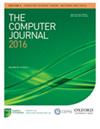异构会议节点聚集
IF 1.5
4区 计算机科学
Q4 COMPUTER SCIENCE, HARDWARE & ARCHITECTURE
引用次数: 0
摘要
摘要考虑两组有限且不相交的同构机器人分布在一个无限网格图的节点上。网格图还包括位于网格节点上的两个有限且不相交的前缀会议节点集。我们的研究目标是设计一种分布式算法,将第一个团队的所有机器人聚集在第一类会议节点之一,而第二个团队的所有机器人必须聚集在第二类会议节点之一。机器人可以区分两种类型的会面节点。然而,机器人无法识别其团队成员。本文假设最强对抗模型,即异步调度。我们描述了集合问题无法解决的所有初始配置。对于剩余的初始配置,本文提出了一种分布式采集算法。假设机器人具有全局弱多重性检测能力,该算法在有限时间内解决了问题。算法以$\Theta (dn)$ moves和$O(dn)$ epochs的形式运行,其中$d$是初始配置中所有机器人和会议节点的最小封闭矩形的直径,$n$是系统中机器人的总数。本文章由计算机程序翻译,如有差异,请以英文原文为准。
Gathering Over Heterogeneous Meeting Nodes
Abstract We consider two finite and disjoint sets of homogeneous robots deployed at the nodes of an infinite grid graph. The grid graph also comprises two finite and disjoint sets of prefixed meeting nodes located over the nodes of the grid. The objective of our study is to design a distributed algorithm that gathers all the robots belonging to the first team at one of the meeting nodes belonging to the first type, and all the robots in the second team must gather at one of the meeting nodes belonging to the second type. The robots can distinguish between the two types of meeting nodes. However, a robot cannot identify its team members. This paper assumes the strongest adversarial model, namely the asynchronous scheduler. We have characterized all the initial configurations for which the gathering problem is unsolvable. For the remaining initial configurations, the paper proposes a distributed gathering algorithm. Assuming the robots are capable of global-weak multiplicity detection, the proposed algorithm solves the problem within a finite time period. The algorithm runs in $\Theta (dn)$ moves and $O(dn)$ epochs, where $d$ is the diameter of the minimum enclosing rectangle of all the robots and meeting nodes in the initial configuration, and $n$ is the total number of robots in the system.
求助全文
通过发布文献求助,成功后即可免费获取论文全文。
去求助
来源期刊

Computer Journal
工程技术-计算机:软件工程
CiteScore
3.60
自引率
7.10%
发文量
164
审稿时长
4.8 months
期刊介绍:
The Computer Journal is one of the longest-established journals serving all branches of the academic computer science community. It is currently published in four sections.
 求助内容:
求助内容: 应助结果提醒方式:
应助结果提醒方式:


